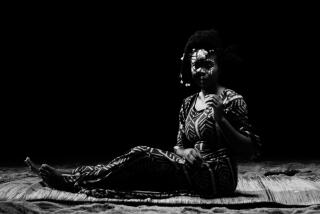BY DESIGN : Hairdos With a Twist
- Share via
Mame Mbaye’s hands don’t seem special. They are of average size with lean fingers and short nails. They are smooth and their skin is dark brown. But when Mbaye braids hair, those hands fascinate. Onlookers can’t believe how deftly they move, weaving, twisting, wrapping hair into styles that just don’t accent a face, but glorify it.
And on Sunday, Mbaye had a formal audience for her work. At UCLA’s Fowler Museum of Cultural History, Mbaye, along with Dieynaba Gaye and Daba Diene, demonstrated West African braiding techniques as part of the exhibition “Crowning Achievements: African Arts of Dressing the Head.” The exhibit, which runs until July 16, features traditional and contemporary hats, headdresses and hairstyles from Africa, and explores their aesthetics and meaning.
The demonstration drew a multicultural and multi-generational crowd of about 60 people curious about a practice taught at a mother’s knee and shared among African and African American women.
“The braiding is something very human,” says Betsy D. Quick, the Fowler’s director of education. “It shows the artfulness of the individual self thoroughly expressed.”
Before a table with dummy heads, hair pomade and a purple pick, the three Senegalese natives were peppered with questions about their craft (“Are those corn rows?” “How long do the braids last?” “Can you wash your hair?” “Does it hurt to sleep?”), and they answered patiently. (“No. Corn rows are braids that lay flat against the head.” “They can last two or three months depending on the style.” “Yes, you can wash your hair.” “Yes, it hurts sometimes for a day or two, but we are women. We handle that.”)
As they spoke, the women illustrated their words with styles ranging from individual braids to corkscrews. One dummy head featured the style called Laxas, a Wolof word meaning wrap . Stylists add synthetic hair to a client’s hair. It’s all then twisted and wrapped with more synthetic hair or cotton thread. The resulting stiff, tendril-like coils of hair must be soaked in hot water to shape.
Gay Lambert came to the demonstration in her own Laxas style--she wraps her shoulder-length dreadlocks with synthetic hair. As an African American, she sees benefits for all in the demonstration. “It bridges the gaps,” she says. “I’m glad for the awareness and the chance for everyone to get together and learn about this culture.”
Quick agrees: “It’s a step in breaking down the walls for those people who think (when they see braids), ‘This is something exotic.’ ”
To 5-year-old Carolyn Hoeckmann-Percival, the braiding is perhaps not so much exotic as awesome. In flower-print dress and pink patent leather shoes, she watches shyly, but intently. Finally, with a little prodding from Dad, she agrees to have her hair braided. Gaye weaves a swath of synthetic hair into Carolyn’s curly sandy brown mane, giving her a long French braid. When it’s done, Carolyn models. Everyone applauds. Carolyn beams.
More to Read
The biggest entertainment stories
Get our big stories about Hollywood, film, television, music, arts, culture and more right in your inbox as soon as they publish.
You may occasionally receive promotional content from the Los Angeles Times.










